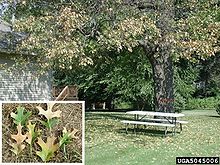Landowner Info
Oak wilt
 |
| Photograph of leaf and whole tree symptoms of oak wilt in a red oak tree. Joseph O'Brien, USDA Forest Service, Bugwood.org |
Asian Longhorned Beetle
The Asian longhorned beetle (ALB, Anoplophora glabripennis) is a destructive wood-boring pest of maple and other hardwoods. ALB was first discovered on several hardwood trees in the United States in Brooklyn, New York, in August 1996. ALB is believed to have been introduced into the United States from wood pallets and other wood packing material accompanying cargo shipments from Asia. ALB was later detected in Chicago, Illinois, in July 1998. The Secretary of Agriculture declared an emergency in order to combat the infestation with regulatory and control actions. In October 2002, the beetle was found in Hudson County, New Jersey, and then in Middlesex and Union Counties, New Jersey, in August 2004. In August 2008, ALB was discovered in Worcester County, Massachusetts, and in July 2010, ALB was found in Suffolk County, Massachusetts. Most recently, ALB was confirmed in Clermont County, Ohio, in June 2011.
For more information, contact the USDA, Animal and Plant Health Inspection Service or your local Department of Agriculture Office or go to www.aphis.usda.gov.
